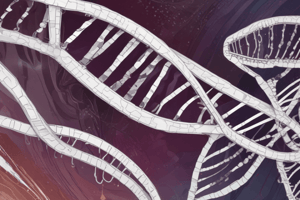Podcast
Questions and Answers
What is the primary mechanism responsible for the development of Trisomy 13?
What is the primary mechanism responsible for the development of Trisomy 13?
- Translocation of chromosomes
- Mitotic nondisjunction
- Meiotic nondisjunction (correct)
- Abnormal fusion of prechordal mesoderm
What is the characteristic facial anomaly often seen in Trisomy 13?
What is the characteristic facial anomaly often seen in Trisomy 13?
- High-set ears
- Low-set, malformed ears (correct)
- Bulbous nose with a long philtrum
- Small eyes with a prominent forehead
What is the most common congenital heart defect seen in Trisomy 13?
What is the most common congenital heart defect seen in Trisomy 13?
- Atrial septal defect
- Patent foramen ovale
- Tetralogy of Fallot
- Ventricular septal defect (correct)
What is the incidence of Trisomy 13 in live births?
What is the incidence of Trisomy 13 in live births?
What is the typical prognosis for infants with Trisomy 13?
What is the typical prognosis for infants with Trisomy 13?
What is the term for the congenital absence of skin, often seen in Trisomy 13?
What is the term for the congenital absence of skin, often seen in Trisomy 13?
What is the term for the small orbits, which may be unilateral or bilateral, seen in Trisomy 13?
What is the term for the small orbits, which may be unilateral or bilateral, seen in Trisomy 13?
What is the first trimester screening test used to detect Trisomy 13?
What is the first trimester screening test used to detect Trisomy 13?
Flashcards are hidden until you start studying
Study Notes
Trisomy 13 (Patau Syndrome)
Karyotype
- Female: 47,XX,+13
- Male: 47,XY,+13
Incidence
- Approximately 1 in 7,400 live births
Pathogenesis
- Meiotic nondisjunction
- Abnormal fusion of prechordal mesoderm leading to midline defects
Clinical Features
Craniofacial Anomalies
- Microcephaly
- Holoprosencephaly
- Characteristic facial anomalies
- Cleft lip and palate
- Low-set, malformed ears
- Bulbous nose
- Small chin
Ocular Anomalies
- Microphthalmia (small orbits) - unilateral or bilateral
- Coloboma
- Ocular hypotelorism
Limb Anomalies
- Polydactyly (primarily hexadactyly)
- Flexed fingers
Cardiovascular Anomalies
- Congenital heart defects
- Ventricular septal defect
- Patent ductus arteriosis
Skin Anomalies
- Aplasia cutis congenita: congenital absence of skin (scalp lesions with a punched-out appearance)
- Capillary hemangioma
Other Anomalies
- Rocker-bottom feet
- Omphalocele
- Visceral and genital anomalies (e.g., polycystic kidney disease)
Diagnostics
- Detected during first trimester screening with combined ultrasound and maternal serum testing
- Decreased PAPP-A, increased nuchal translucency
Prognosis
- Infants usually die before the age of 1
- Only approximately 11% of infants survive past 12 months of age
Mnemonic
- 7 Ps of Patau syndrome: holoprosencephaly, cleft lip and palate, polydactyly, pump disease (congenital heart disease), polycystic kidney disease, cutis aplasia
Studying That Suits You
Use AI to generate personalized quizzes and flashcards to suit your learning preferences.



